Themed collection Materials for thermally activated delayed fluorescence and/or triplet fusion upconversion

Materials for thermally activated delayed fluorescence and/or triplet fusion upconversion
Guest editors Malika Jeffries-EL, Nobuhiro Yanai and Eli Zysman-Colman introduce this themed issue on thermally activated delayed fluorescence, and triplet–triplet annihilation-based photon upconversion, materials.

J. Mater. Chem. C, 2022,10, 4454-4455
https://doi.org/10.1039/D2TC90053J
Challenges, progress and prospects in solid state triplet fusion upconversion
Photon upconversion (UC) stands for the conversion of low to high energy photons, a promising approach to improve solar cells. While high efficiencies can be obtained in liquid UC, will a solid UC device be able to reach such levels?
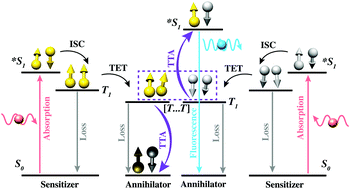
J. Mater. Chem. C, 2022,10, 7783-7798
https://doi.org/10.1039/D1TC05659J
Application of time-resolved electron paramagnetic resonance spectroscopy in the mechanistic study of thermally activated delayed fluorescence (TADF) materials
The photophysical insights of thermally activated delayed fluorescence emitters for OLEDs obtained by time-resolved EPR spectroscopy were summarized.

J. Mater. Chem. C, 2022,10, 4546-4557
https://doi.org/10.1039/D1TC04888K
Exceptional class of thermally activated delayed fluorescent emitters that display pure blue, near-IR, circularly polarized luminescence and multifunctional behaviour for highly efficient and stable OLEDs
This review presents design strategies to obtain novel materials, for generating unique sets of photophysical properties with structure-functionality that can influence their triplet-to-singlet upconversion, leading to efficient OLEDs.
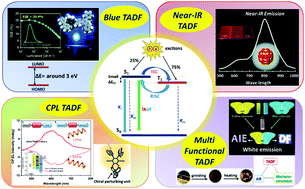
J. Mater. Chem. C, 2022,10, 8536-8583
https://doi.org/10.1039/D1TC05906H
Intermolecular TADF: bulk and interface exciplexes
Intermolecular TADF including bulk and interface exciplexes, can be used as emitters to achieve high efficiency, and also as hosts to extend the device lifetime by reducing the triplet exciton concentration and improving charge balance.
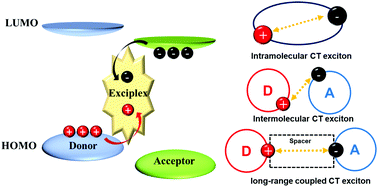
J. Mater. Chem. C, 2022,10, 4521-4532
https://doi.org/10.1039/D1TC04950J
Thermally activated delayed fluorescence in an optically accessed soft matter environment
The experimental requirements for reproducible, all-optical and minimally invasive temperature sensing, based on the temperature dependence of the triplet–triplet annihilation photon upconversion (TTA–UC) in a soft matter environment are reviewed.

J. Mater. Chem. C, 2022,10, 4533-4545
https://doi.org/10.1039/D1TC04915A
Recent progress of sulphur-containing high-efficiency organic light-emitting diodes (OLEDs)
Recent progress of efficient OLEDs based on sulphur-containing heterocyclic compounds, thiophene, phenylsulfone, thiazole and phenothiazine, as appealing building blocks for the new generation of luminogens, is systematically summarized.

J. Mater. Chem. C, 2022,10, 4497-4520
https://doi.org/10.1039/D1TC05255A
Recent advances in materials for and applications of triplet–triplet annihilation-based upconversion
We provide a review of the progress in materials and applications of TTA-UC: biological, environmental/energy, OLED, and other applications. Moreover, an excellent demonstration of TTA-UC based technologies are presented in each chapter.
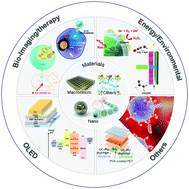
J. Mater. Chem. C, 2022,10, 4483-4496
https://doi.org/10.1039/D1TC03551G
TADF: Enabling luminescent copper(I) coordination compounds for light-emitting electrochemical cells
In this review, we illustrate how the field of luminescent copper(I) compounds has developed with a focus on ionic copper(I) complexes and those exhibiting thermally-activated delayed fluorescence (TADF).
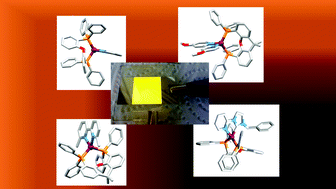
J. Mater. Chem. C, 2022,10, 4456-4482
https://doi.org/10.1039/D1TC04028F
A gold(III)–TADF emitter as a sensitizer for high-color-purity and efficient deep-blue solution-processed OLEDs
Herein is described a blue-emitting gold(III)–TADF complex serving as a sensitizer for SP-OLEDs, in which an MR-TADF emitter is employed as the emissive dopant. The SP-OLEDs attained EQEmax of up to 16.6%, high color purity and CIEx,y of (0.14, 0.18).

J. Mater. Chem. C, 2022,10, 4590-4596
https://doi.org/10.1039/D1TC05487B
Heavy metal-free visible-to-UV photon upconversion with over 20% efficiency sensitized by a ketocoumarin derivative
The highest efficiency of heavy metal-free visible-to-UV photon upconversion is achieved by employing a ketocoumarin sensitizer with strong visible absorption, weak UV absorption, and high intersystem crossing efficiency.

J. Mater. Chem. C, 2022,10, 4558-4562
https://doi.org/10.1039/D1TC05526G
Near-infrared-to-visible upconversion from 980 nm excitation band by binary solid of PbS quantum dot with directly attached emitter
Solid mixture of PbS quantum dot and a directly attached emitter penetrating the ligand layer enables photon upconversion from near infrared.
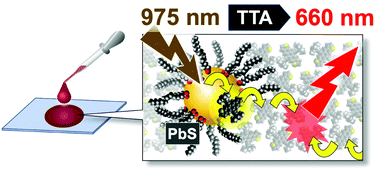
J. Mater. Chem. C, 2022,10, 4563-4567
https://doi.org/10.1039/D1TC05058C
Highly efficient triplet–triplet annihilation upconversion in polycaprolactone: application to 3D printable architectures and microneedles
This research reports the next generation of solid-state triplet–triplet annihilation upconversion (TTA-UC) host material (polycaprolactone, PCL) for highly efficient, processable, and biocompatible solid-state TTA-UC.
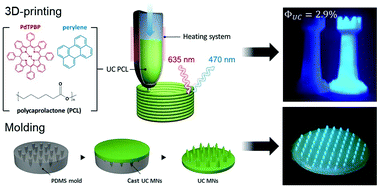
J. Mater. Chem. C, 2022,10, 4584-4589
https://doi.org/10.1039/D1TC04834A
Deep-red electro-fluorescence based on an excimer emission with hot-exciton channels
This work not only gives a new functional group for the construction of deep-red pure organic efficient excimer materials, but also further verifies that the “hot exciton” theory can also be effective in excimer-based OLEDs.

J. Mater. Chem. C, 2022,10, 4579-4583
https://doi.org/10.1039/D1TC04920H
Purely organic Vis-to-UV upconversion with an excited annihilator singlet beyond 4 eV
Biphenyl at its best: a (triisopropylsilyl)ethynyl group in para position converts biphenyl into a UV annihilator that is successfully employed for blue-to-UV upconversion with unprecedented output photon energies.
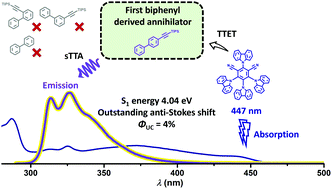
J. Mater. Chem. C, 2022,10, 4568-4573
https://doi.org/10.1039/D1TC04782E
Ester-functionalized thermally activated delayed fluorescence materials
A family of thermally activated delayed fluorescence (TADF) materials functionalized with carboxylate esters is developed.
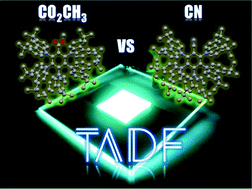
J. Mater. Chem. C, 2022,10, 4574-4578
https://doi.org/10.1039/D1TC04933J
Mechanical-load and temperature-engendered degradation of α-CsPbI3: reactive molecular dynamics simulation
The structural stability of CsPbI3 has been studied using reactive molecular dynamics simulation under mechanical-load and temperature induced stress.
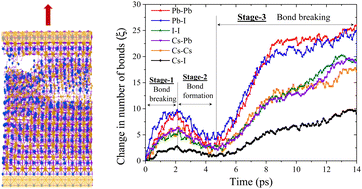
J. Mater. Chem. C, 2022,10, 12091-12105
https://doi.org/10.1039/D2TC02298B
Thermally activated delayed fluorescence poly(dendrimer)s – detrapping excitons for reverse intersystem crossing
We compare the effect of donor strength on the optoelectronic properties of thermally activated delayed fluorescence poly(dendrimer)s and their dendrimer analogues.
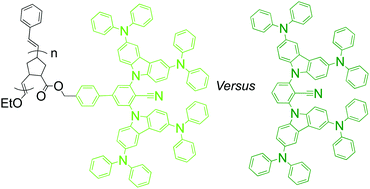
J. Mater. Chem. C, 2022,10, 8109-8124
https://doi.org/10.1039/D1TC05151B
Influence of regioisomerism in bis(terpyridine) based exciplexes with delayed fluorescence
Structural diversity of different BTPs in exciplexes together with TCTA is investigated, to improve their performance in TADF OLEDs.
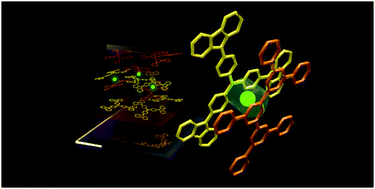
J. Mater. Chem. C, 2022,10, 7699-7706
https://doi.org/10.1039/D2TC00800A
Triplet photodynamic and up-conversion luminescence in donor–acceptor dyads with slip-stacked vs. co-facial arrangement
Engineering of donor–acceptor light-harvesting systems based on geometrical features: applications in energy transfer & energy/photon upconversion.
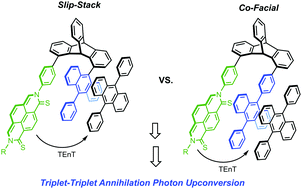
J. Mater. Chem. C, 2022,10, 7093-7102
https://doi.org/10.1039/D1TC05122A
Simultaneous enhancement of thermally activated delayed fluorescence and photoluminescence quantum yield via homoconjugation
A new iptycene unequivocally validates homoconjugation as a viable strategy to simultaneously enhance TADF reverse intersystem crossing and radiative decay.
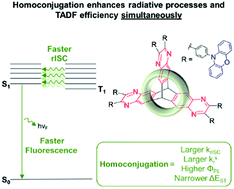
J. Mater. Chem. C, 2022,10, 6306-6313
https://doi.org/10.1039/D2TC00460G
Efficient NIR-to-vis photon upconversion in binary rubrene films deposited by simplified thermal evaporation
Simplified thermal evaporation of rubrene in an inert atmosphere is demonstrated to alter the morphology of photon upconverting (UC) films, and subsequently ramp their NIR-to-vis UC quantum yield up to a record value of 1.2% (out of maximum 50%).
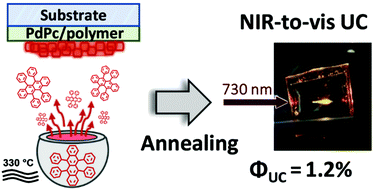
J. Mater. Chem. C, 2022,10, 6314-6322
https://doi.org/10.1039/D1TC05332A
Dominant dimer emission provides colour stability for red thermally activated delayed fluorescence emitter
4DTPIPN has a strong tendency for dimer formation, even in dilute film, and possesses a higher colour purity than 4CzIPN but this is traded-off against the photoluminescence quantum yield. (Credit to LeStudio/Shutterstock for the James Bond themed background.)

J. Mater. Chem. C, 2022,10, 5840-5848
https://doi.org/10.1039/D1TC04913E
A phosphorescent OLED with an efficiency roll-off lower than 1% at 10 000 cd m−2 achieved by reducing the carrier mobility of the donors in an exciplex co-host system
A phosphorescent OLED with an external quantum efficiency of 22.31% and an extremely low efficiency roll-off of 0.67% at 10 000 cd m−2 was achieved by reducing the carrier mobility of the donors in an exciplex co-host system.

J. Mater. Chem. C, 2022,10, 4955-4964
https://doi.org/10.1039/D1TC04473G
Harnessing near-infrared light via S0 to T1 sensitizer excitation in a molecular photon upconversion solar cell
An Osmium sensitizer and anthracene annihilator are incorporated into a metal ion linked multilayer photoanode that harnesses NIR light in an integrated triplet–triplet annihilation upconversion solar cell.
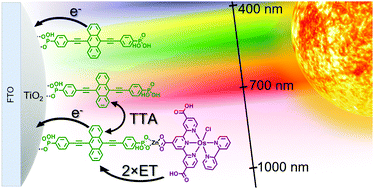
J. Mater. Chem. C, 2022,10, 4947-4954
https://doi.org/10.1039/D1TC05270E
Modulating TTA efficiency through control of high energy triplet states
It is shown here that positional isomerism of perylene substitution affects high energy triplet states differently. This in turn influences the quantum efficiency of triplet–triplet annihilation photon upconversion.
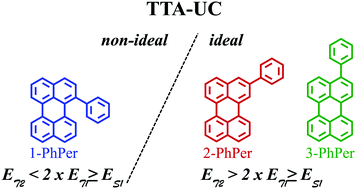
J. Mater. Chem. C, 2022,10, 4923-4928
https://doi.org/10.1039/D1TC05292F
Toward rational design of TADF two-coordinate coinage metal complexes: understanding the relationship between natural transition orbital overlap and photophysical properties
A series of twelve two-coordinate coinage metal, Cu, Ag and Au, complexes with carbene-metal-amide structures were prepared and used to study the correlation of the overlap between the hole and electron NTOs with the electronic and photophysical properties of these TADF emitters.

J. Mater. Chem. C, 2022,10, 4674-4683
https://doi.org/10.1039/D2TC00163B
Triplet-to-singlet exciton transfer in hyperfluorescent OLED materials
In addition to reverse intersystem crossing, triplet-to-singlet exciton transfers plays an important role in the triplet harvesting mechanism in hyperfluorescent organic light-emitting diodes.
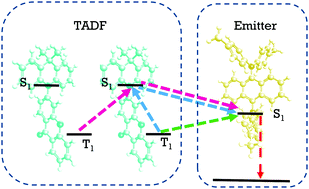
J. Mater. Chem. C, 2022,10, 4914-4922
https://doi.org/10.1039/D1TC05596H
1,4-Bis(trifluoromethyl)benzene as a new acceptor for the design and synthesis of emitters exhibiting efficient thermally activated delayed fluorescence and electroluminescence: experimental and computational guidance
Impacts of intramolecular non-covalent interactions of TADF emitters on their electroluminescent performances were investigated using donor-acceptor compounds containing moiety 1,4-bis(trifluoromethyl)benzene.
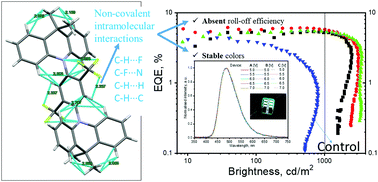
J. Mater. Chem. C, 2022,10, 4929-4940
https://doi.org/10.1039/D1TC05420A
Determining non-radiative decay rates in TADF compounds using coupled transient and steady state optical data
Understanding the role of non-radiative decay rates in TADF OLEDs by comparing PLQY and ELQY simulated values. Quantification of the non-radiative decay rates in TADF compounds with a sophisticated fitting procedure.
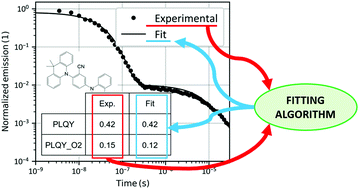
J. Mater. Chem. C, 2022,10, 4878-4885
https://doi.org/10.1039/D1TC05594A
Indeno-anthraquinone hosts with thermally activated delayed fluorescence for deep-red OLEDs
High efficiency and reduced efficiency roll-off were realized for a cationic iridium complex with deep-red emission based on an indeno-anthraquinone host endowing thermally activated delayed fluorescence.
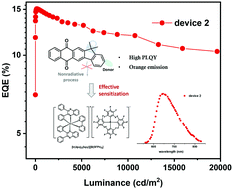
J. Mater. Chem. C, 2022,10, 4668-4673
https://doi.org/10.1039/D1TC04962C
Photoluminescence and electrochemiluminescence of thermally activated delayed fluorescence (TADF) emitters containing diphenylphosphine chalcogenide-substituted carbazole donors
We have successfully developed blue-emitting thermally activated delayed fluorescence (TADF) compounds derived from 2CzPN. They display novel electrochemiluminescence properties, these revealing correlations with measured ΔEST values.

J. Mater. Chem. C, 2022,10, 4646-4667
https://doi.org/10.1039/D1TC05696D
The regioisomeric effect on the excited-state fate leading to room-temperature phosphorescence or thermally activated delayed fluorescence in a dibenzophenazine-cored donor–acceptor–donor system
Regioisomeric and substituent effects in a twisted D–A–D molecular scaffold on the photophysical properties has been revealed. The studied compounds display distinct difference in TADF, dual TADF&RTP, and dual RTP, depending on the host used.
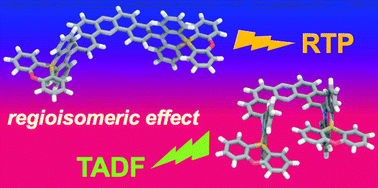
J. Mater. Chem. C, 2022,10, 4905-4913
https://doi.org/10.1039/D1TC05730H
Microfluidic oxygen tolerability screening of nanocarriers for triplet fusion photon upconversion
A new microfluidic approach was used to screen the oxygen tolerability of photon upconverting nanocarriers and to quantify their performance at oxygen levels ranging from severely hypoxic tumours to healthy peripheral tissue.
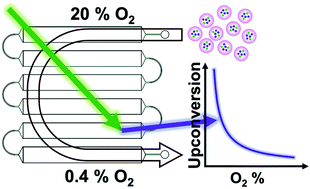
J. Mater. Chem. C, 2022,10, 4871-4877
https://doi.org/10.1039/D2TC00156J
A deep blue thermally activated delayed fluorescence emitter: balance between charge transfer and color purity
A TADF emitter exhibiting high OLED device performance of 25% and narrow emission (FWHM = 58 nm) in the deep blue region (λem = 458 nm, CIE = 0.14, 0.13) due to balanced charge transfer interactions and locked molecular geometry.

J. Mater. Chem. C, 2022,10, 4886-4893
https://doi.org/10.1039/D1TC05027C
An S-shaped double helicene showing both multi-resonance thermally activated delayed fluorescence and circularly polarized luminescence
We present the first example of a MR-TADF extended helicene.
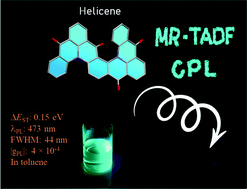
J. Mater. Chem. C, 2022,10, 4861-4870
https://doi.org/10.1039/D2TC00198E
Influence of perhalophenyl groups in the TADF mechanism of diphosphino gold(I) complexes
Four new perhalophenylgold(I)–diphosphino complexes have been described as TADF emitters. The position and the electronegativity of the halogen atoms in the aromatic ring allow tuning of the photophysical properties.
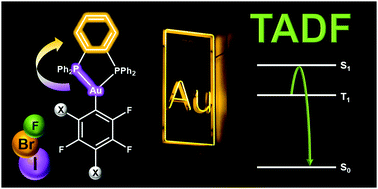
J. Mater. Chem. C, 2022,10, 4894-4904
https://doi.org/10.1039/D1TC04905D
Efficient narrowband electroluminescence based on a hetero-bichromophore thermally activated delayed fluorescence dyad
A hetero-bichromophore thermally activated delayed fluorescence (TADF) emitter named BOQAO was designed and synthesized, which consists of two multi-resonance TADF (MR-TADF) cores, tBuBO and tBuQAO.
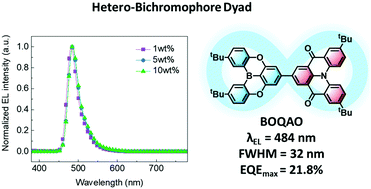
J. Mater. Chem. C, 2022,10, 4941-4946
https://doi.org/10.1039/D1TC05711A
Boosting organic afterglow efficiency via triplet–triplet annihilation and thermally-activated delayed fluorescence
TTA and TADF mechanisms with moderate rate constants on the order of 10−1 to 101 s−1 have been incorporated into dopant–matrix systems to significantly enhance the organic afterglow efficiency under ambient conditions.
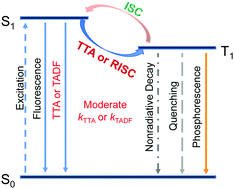
J. Mater. Chem. C, 2022,10, 4795-4804
https://doi.org/10.1039/D1TC04903H
Enhancement of thermally activated delayed fluorescence properties by substitution of ancillary halogen in a multiple resonance-like diplatinum(II) complex
Metathesis of the halide co-ligands X from chloro to iodo improves the TADF properties in a diplatinum(II) complex of the form (N^C^N–N^C^N)Pt2X2, leading to a ∼3-fold increase of radiative decay rate constant.
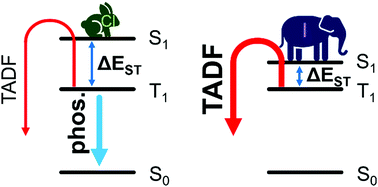
J. Mater. Chem. C, 2022,10, 4851-4860
https://doi.org/10.1039/D1TC05026E
Aggregation-induced emission active thermally-activated delayed fluorescence materials possessing N-heterocycle and sulfonyl groups
Novel thermally-activated delayed fluorescence (TADF) materials 2Cz2SB and 2Mi2SB, possessing N-heterocycle and arylsulfonyl groups, were synthesized and their photophysical properties in solution and the solid state were characterized.
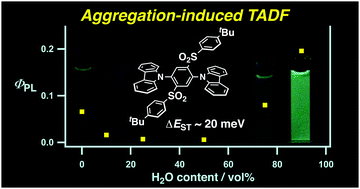
J. Mater. Chem. C, 2022,10, 4607-4613
https://doi.org/10.1039/D1TC05196B
Energy transfer processes in hyperfluorescent organic light-emitting diodes
In an efficient hyperfluorescent ternary blend, most of the singlet excitons from the TADF sensitizers will efficiently transfer to the emitters while the triplet excitons will first undergo a reverse intersystem crossing transition.
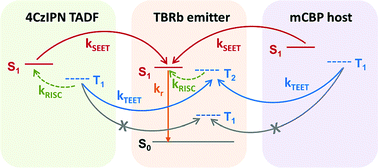
J. Mater. Chem. C, 2022,10, 4629-4636
https://doi.org/10.1039/D1TC05090G
Rapid predictions of the colour purity of luminescent organic molecules
Designing luminescent organic materials exhibiting narrowband emission is crucial for achieving high resolution and energy efficient organic light emitting diodes (OLEDs), but remains a significant challenge.
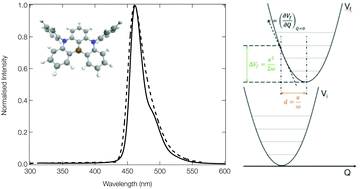
J. Mater. Chem. C, 2022,10, 4785-4794
https://doi.org/10.1039/D1TC04748E
Frontier molecular orbital engineering in spiro-based molecules: achieving aggregation-induced delayed fluorescence for non-doped OLEDs
Different from spiro-blocking, frontier molecular orbital engineering has been proposed to develop AT-spiro-DMACF, which shows interesting aggregation-induced delayed fluorescence (AIDF) for non-doped OLEDs.

J. Mater. Chem. C, 2022,10, 4845-4850
https://doi.org/10.1039/D1TC05225J
A solution-processable near-infrared thermally activated delayed fluorescent dye with a fused aromatic acceptor and aggregation induced emission behavior
Here a new electron donor is developed to endow a near-IR TADF molecule with good solubility for solution processing and AIE behavior. This is the first AIE TADF material with all PL > 700 nm.
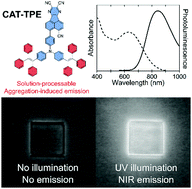
J. Mater. Chem. C, 2022,10, 4831-4836
https://doi.org/10.1039/D1TC04753A
Effective models for TADF: the role of the medium polarizability
Building on an effective model Hamiltonian for DMAC–TRZ, a non-adiabatic approach is proposed to estimate (reverse) inter-system crossing rates and to address the role of the polarizability of the matrix in the properties of TADF emitters.

J. Mater. Chem. C, 2022,10, 4620-4628
https://doi.org/10.1039/D1TC05296A
Bridge control of photophysical properties in benzothiazole-phenoxazine emitters – from thermally activated delayed fluorescence to room temperature phosphorescence
Three phenoxazine-π-bridge-benzothiazole dyes are investigated by a joint experimental-computational approach. Depending on the linker, TADF or RTP (also in solution) is observed.

J. Mater. Chem. C, 2022,10, 4775-4784
https://doi.org/10.1039/D1TC04885F
Manipulating Förster and Dexter interactions between a thermally activated delayed fluorescence host and a phosphorescent dopant for highly efficient solution-processed red and white OLEDs
A blue TADF host with and without steric hindrances was utilized to manipulate Fӧrster and Dexter interactions with a red phosphorescent iridium complex, realizing the state-of-the-art PhOLEDs with a sufficiently high EQE of 22.2%.
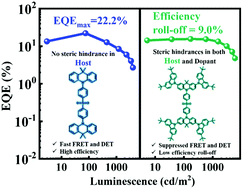
J. Mater. Chem. C, 2022,10, 4637-4645
https://doi.org/10.1039/D1TC05470H
Asymmetric sky-blue thermally-activated delayed fluorescence emitters bearing tris(triazolo)triazine moiety for solution-processable organic light-emitting diodes
Two sky-blue TADF emitters bearing the tris(triazolo)triazine acceptor moiety were designed and synthesized. The solution-processed OLEDs based on these two emitters achieved a maximum EQE of 10.01% at 474 nm.

J. Mater. Chem. C, 2022,10, 4837-4844
https://doi.org/10.1039/D1TC05372H
Aromatic-imide-based TADF enantiomers for efficient circularly polarized electroluminescence
A pair of chiral aromatic-imide-based TADF emitters were conveniently constructed for the fabrication of highly efficient CP-OLEDs.
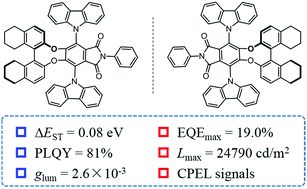
J. Mater. Chem. C, 2022,10, 4805-4812
https://doi.org/10.1039/D1TC04893G
Enhanced blue TADF in a D–A–D type naphthyridine derivative with an asymmetric carbazole-donor motif
An asymmetric carbazole-donor motif in a D–A–D type naphthyridine-based TADF emitter enables CT/LE state mixing, thus enhancing the RISC rate, shortening the delayed fluorescence lifetime and reducing the OLED efficiency roll-off.
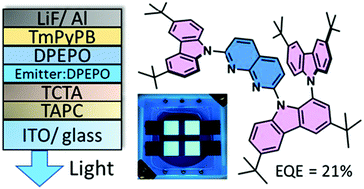
J. Mater. Chem. C, 2022,10, 4813-4820
https://doi.org/10.1039/D1TC05061C
A reverse intersystem crossing managing assistant dopant for high external quantum efficiency red organic light-emitting diodes
Assistant dopants with reduced Dexter energy transfer rates were designed by replacing the donor moiety of 2,3,5,6-tetra(9H-carbazol-9-yl)terephthalonitrile (4CzTPN) with 5H-benzo[4,5]thieno[3,2-c]carbazole (BTCz).
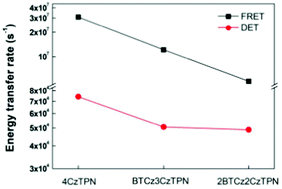
J. Mater. Chem. C, 2022,10, 4821-4830
https://doi.org/10.1039/D1TC04875A
High-performance solution-processed red hyperfluorescent OLEDs based on cibalackrot
Solution-processed hyperfluorescent red organic light-emitting diodes with external quantum efficiencies of 15.3% was achieved by using cibalackrot as the fluorescent emitter, where attaching tert-butyl groups to the assistant host significantly contributes to device performance.

J. Mater. Chem. C, 2022,10, 4767-4774
https://doi.org/10.1039/D1TC04937B
Unravelling the origin of dual photoluminescence in Au2Cu6 clusters by triplet sensitization and photon upconversion
Ligand-protected Au2Cu6 cluster exhibits not only fluorescence but also phosphorescence at room temperature and serves as a triplet sensitizer in triplet fusion upconversion.
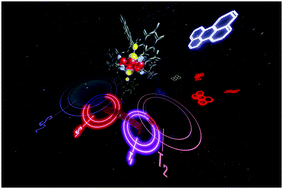
J. Mater. Chem. C, 2022,10, 4597-4606
https://doi.org/10.1039/D1TC04591A
Fluorinated dibenzo[a,c]-phenazine-based green to red thermally activated delayed fluorescent OLED emitters
Fluorinated dibenzo[a,c]-phenazine-based green to red thermally activated delayed fluorescent OLED emitters are accessible through judicious choice of donor.
![Graphical abstract: Fluorinated dibenzo[a,c]-phenazine-based green to red thermally activated delayed fluorescent OLED emitters](/en/Image/Get?imageInfo.ImageType=GA&imageInfo.ImageIdentifier.ManuscriptID=D1TC04918F&imageInfo.ImageIdentifier.Year=2022)
J. Mater. Chem. C, 2022,10, 4757-4766
https://doi.org/10.1039/D1TC04918F
Highly efficient blue electroluminescence based on TADF emitters with spiroacridine donors: methyl group effect on photophysical properties
An unusual methyl group effect for designing TADF emitters was revealed, and the resulting blue OLEDs achieved a maximum EQE of nearly 20%.
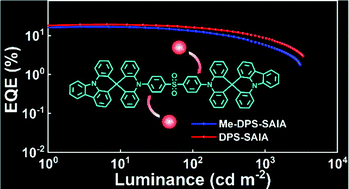
J. Mater. Chem. C, 2022,10, 4614-4619
https://doi.org/10.1039/D1TC04939A
The effect of molecular aggregation of thermally activated delayed fluorescence sensitizers for hyperfluorescence in organic light-emitting diodes
DMAC-DPS showing AIE behavior increased TTA and STA, whereas Ph-OBNA showing ACQ behavior showed relatively small TTA and STA values due to the generation of excimers.
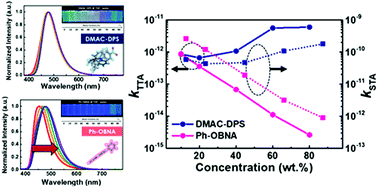
J. Mater. Chem. C, 2022,10, 4705-4716
https://doi.org/10.1039/D1TC04712D
Harnessing bipolar acceptors for highly efficient exciplex-forming systems
Two bipolar molecules CzT2.1 and CzT2.2 are examined as electron acceptors to form exciplexes with electron donors 1,1-bis[(di-4-tolylamino)phenyl]cyclohexane (TAPC) and 4,4′,4′′-tris(carbazol-9-yl)-triphenylamine (TCTA), respectively.
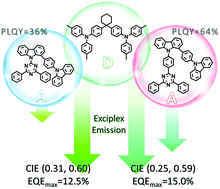
J. Mater. Chem. C, 2022,10, 4748-4756
https://doi.org/10.1039/D1TC04700K
Not the sum of their parts: understanding multi-donor interactions in symmetric and asymmetric TADF emitters
Electronic communication uncovered between donor groups in a pair of D–A–D TADF emitters lowers their triplet energies, and shows that they cannot be described purely as combinations of the equivalent D–A systems.
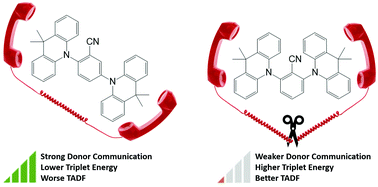
J. Mater. Chem. C, 2022,10, 4737-4747
https://doi.org/10.1039/D1TC04171A
Applying intermolecular hydrogen bonding to exploit TADF emitters for high-performance orange-red non-doped OLEDs
Suitable intermolecular hydrogen bonding interactions enable head-against-tailed 3D supramolecular frameworks and high-performance orange-red non-doped OLEDs were thus realized.
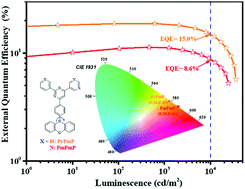
J. Mater. Chem. C, 2022,10, 4717-4722
https://doi.org/10.1039/D1TC03803F
Structure–property relationship study of blue thermally activated delayed fluorescence molecules with different donor and position substitutions: theoretical perspective and molecular design
Blue-efficient thermally-activated delayed fluorescence emitters are widely desired in organic light-emitting diodes due to their advantages in both improving display resolution and providing better pixels.

J. Mater. Chem. C, 2022,10, 4723-4736
https://doi.org/10.1039/D1TC04656J
In optimized rubrene-based nanoparticle blends for photon upconversion, singlet energy collection outcompetes triplet-pair separation, not singlet fission
Conversion of near-infrared photons to visible light in rubrene based systems is made 20x more efficient when mixed with 0.5% wt DBP. This is not because singlet fission in rubrene is supressed, but because of reduced triplet losses.
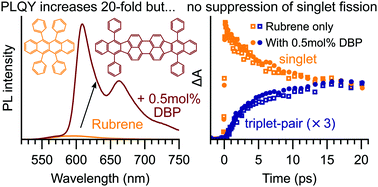
J. Mater. Chem. C, 2022,10, 4684-4696
https://doi.org/10.1039/D1TC02955J
Sensitizing phosphorescent and radical emitters via triplet energy translation from CsPbBr3 nanocrystals
Colloidal CsPbBr3 nanocrystals effectively sensitize surface-attached molecular triplets which can further translate their energy to non-conventional light-emitting materials such as phosphorescent and radical molecules.
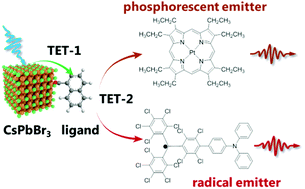
J. Mater. Chem. C, 2022,10, 4697-4704
https://doi.org/10.1039/D1TC04086C
About this collection
We are delighted to introduce a new themed online collection on recent advances in the design of new materials that exhibit the thermally triggered phenomena of delayed fluorescence and/or the triplet-triplet annihilation-based photon upconversion. This collection includes topics on the theoretical and physical design of new materials and the opportunities created by exploiting the unique features of these molecular systems in the field of organic light-emitting diodes and sunlight-powered devices.